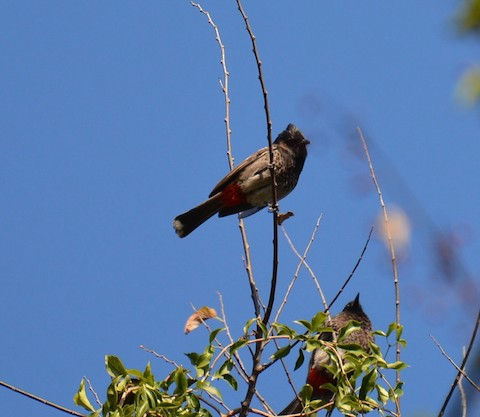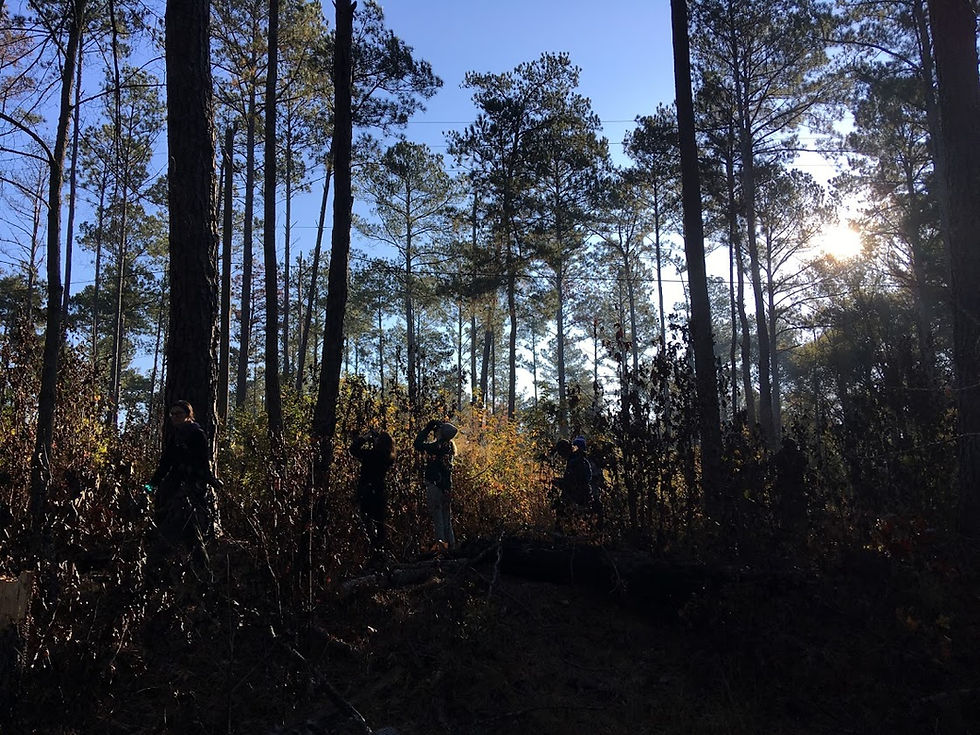Florida Ornithological Society Meeting
- birdsnbrews

- Apr 2, 2020
- 5 min read
Just two weeks after the Georgia Ornithological Society meeting, I headed down south for the Florida Ornithological Society Meeting in Deland. We arrived Friday evening just a few minutes late to a fascinating presentation by Dr. Robert Fletcher from the University of Florida on rapid evolution in Snail Kites, a particular topic of interest to me. Here's a short blog post on it that includes the original scientific article.
After mingling a bit after the presentation to say hello to fellow birders and co-workers, we headed to our B&B to debate which field trips we planned on attending. Peter and I were splitting it with a group of our Tallahassee friends (6 of us in one bedroom...but that's what made it so cheap!)
We woke up early, as birders do, to head down to Merritt Island National Wildlife Refuge, a 140,000-acre area near Titusville and also home to portions of the Kennedy Space Center on the southern end and parts of the Canaveral National Seashore to the north. Merritt Island hosts a diversity of habitats, including scrub, hardwood hammocks, freshwater marshes, dunes, and saltwater estuaries, making it a birding haven in the state and a popular tourist destination. Becky Bolt was our trip leader, a birder and employee of the refuge. Our group arrived earlier than the others, so we birded West Gator Creek and the Oak and Palm Hammock Trail while we waited for the others. Neither spot provided any especially sought-out birds, but the Oak and Palm Hammock trail was gorgeous. I felt nostalgic, growing up in hammock habitat in South Florida, and realized how much I had missed it.

We were soon greeted by the rest of the group, including my advisor, Jim Cox, and his wife, Kate NeSmith, as well as one of my co-workers, Bree, and a hodge-podge of others from all over the state. David Simpson, arguably the best birder in Florida, was also part of our group. There was a wealth of knowledge between all of us, but I would soon realize that the size of the group made it a bit challenging to maintain cohesion.
We headed to a publicly-inaccessible spot on the beach with permission from Becky. She provided us with some of the history of the area, but if I'm being honest, I was too busy trying to scope on the water to hear much of it. I'm definitely a one-minded person, and it's hard for me to converse and bird at the same time. Plus, the clock was really ticking on our Big Year! Others were doing the same, and someone yelled out "gannets!" This was a bird we needed so we stared at the ocean until Peter and I saw one flying by. In total, 6 gannets gracefully glided by, far out of reach.
We caravanned around the seashore for 14 miles, stopping at impoundments where we glimpsed shapes in the water. However, most of them ended up being coots and gallinules, although we did spot a handful of Gadwalls and Northern Pintails. We arrived at the visitor's center and decided to split off from the group, which was moving at a pace a bit slower than our energy levels. But it was starting to get extremely hot, and the chances of seeing good birds was slimming. On top of that, I was giving a presentation at the meeting early in the afternoon. After debating where to head, we decided on Tiger Bay Forest Wildlife Management Area and meandered around for a while. The bird life was slow, but we did manage to find an incredibly adorable baby gopher tortoise!

We were running late and I didn't have time to shower before my presentation. So, still in field clothes and very sweaty, I presented on some of my thesis research on Red-cockaded Woodpecker cavity competition. We listened to research from other students, as well as professional groups working on Florida Grasshopper Sparrow conservation. We were provided a delicious Italian dinner and treated to a wonderful presentation on wading birds populations in the Everglades by Dr. Peter Frederick at the University of Florida.
The next morning we joined another field trip to Lake Apopka, Florida's third largest lake. There's an 11 mile wildlife drive that is a popular birding and photography spot. You might recall from an earlier post that we were here back in July. If you're looking for wading birds, ospreys, coots, and gallinules, the lake certainly does not disappoint. We finally got our first of the year Fulvous Whistling Ducks too! I absolutely adore whistling ducks, and they are aptly named. While I was photographing, our friend Natasza, who takes audio recordings of birds, was trying to capture their cute little whistles. We also had an interesting encounter with a Great Blue Heron, who was putting a ton of effort into trying to swallow an armored catfish, an invasive species. We watched in awe for the better part of 20 minutes, before moving on. He was still wrangling with it when we left.



We had lost the group long ago, moving at a pretty quick pace. Next stop: the Scissor-tailed Flycatcher stakeout. This was a relatively reliable spot to view an absolutely stunning bird. When we arrived, there were several other birders there too. Of course they immediately announced to us that they had the bird early in the morning, but hadn't seen it since. We waited patiently, wandering up and down the road for 30 minutes, without any luck. On a tight schedule, we decided to call it. Quite literally, as soon as we were closing our car doors, one of the birders yelled "It's back!" Sure enough, it perched back on its telephone wire that we had been staring at earlier. After celebrating our victory, we were off to the Mead Botanical Gardens in Orange County for one of our last shots at fall migrants - especially warblers. Unfortunately, we struck out, but we did get to see a Yellow-billed Cuckoo, which is always a treat.
Next, we headed to hell: The Villages in Orlando, Florida. Painted with golf courses, overprices condos, and a CVS every 20 feet, we dreaded being there. But we had a Greater White-fronted Goose to see, and as soon as we saw it, we snapped a few pictures, and hopped back in our cars.

We rushed up to Gainesville to hit one of our favorite spots, Sweetwater Wetlands Park. We met up with Peter's friend Derek, and his girlfriend. We got great looks at Black-crowned Night Herons, a Marsh Wren, a Merlin, and an American Bittern.


Last stop of the trip was at a dingy retention pond in the back of a Dick's Sporting Goods. We were looking for a reported Pectoral Sandpiper, and after a long weekend, there were a few points in which we thought we did see it. Unfortunately, they were just snipes foraging in the mud and the sun was setting quickly, making it even more difficult to see. and we headed back to Tallahassee. I had to drive back to Athens early the next morning. All in all, it wasn't as productive of a weekend as we expected species-wise, but sometimes that's just how it goes. I had a wonderful time among friends, getting a presentation under my belt, and exploring areas I'd never been before!








Comments